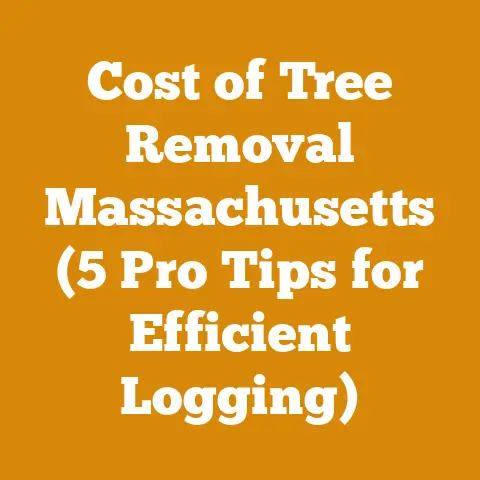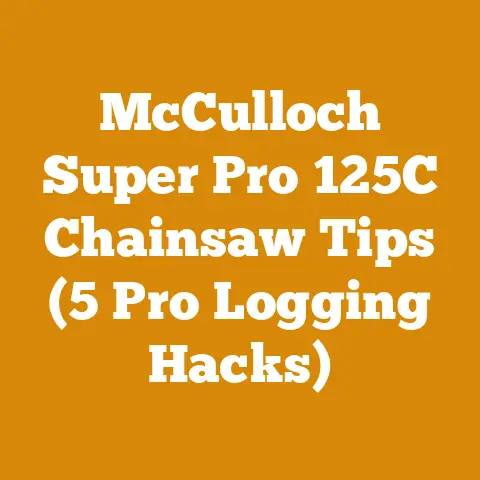Epsom Salt on Tree Stump (5 Pro Tips for Effective Decay)
Maintaining a pristine, manicured yard can sometimes feel like a never-ending battle, especially when dealing with the stubborn remnants of a felled tree. Those unsightly stumps are not only tripping hazards but also potential havens for pests and diseases. While mechanical removal or hiring a professional are viable options, they often come with significant costs and logistical hassles. That’s where the seemingly simple solution of using Epsom salt to accelerate stump decay comes into play. I’ve personally used this method on several occasions, and while it’s not a magical overnight fix, it’s an effective, eco-friendlier, and budget-conscious approach that I’m eager to share with you.
Understanding the Science Behind Epsom Salt and Wood Decay
Before diving into the how-to, it’s essential to understand why Epsom salt, or magnesium sulfate (MgSO₄), is believed to aid in tree stump decay. While Epsom salt is commonly known for its benefits in gardening and personal care, its role in wood decomposition is less about directly “rotting” the wood and more about creating an environment conducive to fungal growth and moisture imbalance.
The Role of Magnesium Sulfate
Magnesium sulfate is a highly soluble salt. When applied to a tree stump, it draws moisture out of the wood, creating a hypertonic environment. This high concentration of salt disrupts the internal water balance of the wood cells. Simultaneously, it can attract moisture from the surrounding soil, leading to cycles of wetting and drying that weaken the wood fibers.
Fungal Decomposition: Nature’s Demolition Crew
The real work of decaying the stump is done by fungi. Wood-decaying fungi are microorganisms that secrete enzymes capable of breaking down lignin and cellulose, the primary structural components of wood. These fungi thrive in moist environments. By creating moisture imbalances and weakening the wood, Epsom salt makes the stump more susceptible to fungal colonization.
Wood Anatomy and Properties
To truly understand how Epsom salt affects wood decay, we need to look at the structure of wood itself. Wood is primarily composed of:
- Cellulose: The main structural component, providing strength and rigidity.
- Lignin: A complex polymer that provides compressive strength and makes wood resistant to decay.
- Hemicellulose: A polysaccharide that binds cellulose and lignin together.
Wood also contains water, both free water within the cell cavities and bound water within the cell walls. The moisture content of wood significantly affects its density, strength, and susceptibility to decay. Freshly cut wood can have a moisture content of over 100% (dry weight basis), while seasoned firewood typically has a moisture content of 20% or less.
Hardwood vs. Softwood: A Key Consideration
The type of wood also plays a crucial role in how quickly it decays. Hardwoods, like oak and maple, are generally denser and more resistant to decay than softwoods, like pine and fir. This is due to the differences in their cellular structure and the presence of extractives, natural compounds that inhibit fungal growth.
Data Point: Oak heartwood can take decades to decompose naturally, while pine sapwood can decay within a few years under favorable conditions.
Therefore, the effectiveness of Epsom salt may vary depending on the type of tree stump you’re dealing with. Hardwood stumps will generally require more time and repeated applications compared to softwood stumps.
Pro Tip 1: Drill Strategically for Maximum Penetration
The first and perhaps most crucial step in using Epsom salt effectively is to ensure it can penetrate deep into the stump. This involves strategic drilling.
Why Drilling Matters
Simply sprinkling Epsom salt on top of the stump will have limited effect. The salt needs to reach the inner layers of the wood to disrupt the moisture balance and create an environment conducive to decay. Drilling provides pathways for the salt to penetrate deeply.
Drilling Technique
- Choose the Right Drill Bit: Use a large drill bit, ideally ¾ inch to 1 inch in diameter. This creates ample space for the Epsom salt crystals.
- Drill Multiple Holes: Drill several holes across the surface of the stump, spaced about 4-6 inches apart. The depth of the holes should be at least 8-12 inches, depending on the size of the stump. For larger stumps, consider drilling even deeper, perhaps up to half the stump’s height.
- Angle the Holes: Angle the drill holes slightly downwards. This helps the Epsom salt solution to pool within the stump, maximizing its contact with the wood fibers.
- Focus on the Cambium Layer: If possible, try to drill into the cambium layer, the layer of actively growing cells just beneath the bark. This layer is particularly susceptible to decay, and targeting it can accelerate the process.
My Personal Experience
I recall dealing with a particularly stubborn oak stump in my backyard. Initially, I just sprinkled Epsom salt on the surface, hoping for the best. After several weeks, I saw minimal progress. Frustrated, I decided to drill multiple deep holes as described above. The difference was remarkable. Within a few months, the stump had softened significantly, and I could easily break off chunks of the decaying wood.
Pro Tip 2: Create a Concentrated Epsom Salt Solution
Epsom salt works best when applied in a highly concentrated solution. This maximizes its osmotic effect, drawing moisture out of the wood and creating an unfavorable environment for healthy wood cells.
Mixing the Solution
- Use Hot Water: Dissolve the Epsom salt in hot water. Hot water increases the solubility of the salt, allowing you to create a more concentrated solution.
- Ratio: Aim for a ratio of about 1 pound of Epsom salt per gallon of hot water. Stir thoroughly until the salt is completely dissolved. You’ll know it’s ready when the water becomes clear.
- Supersaturation: If you want to go the extra mile, you can try creating a supersaturated solution. This involves adding more Epsom salt than the water can normally dissolve at room temperature. As the solution cools, some of the salt may precipitate out, but a significant amount will remain dissolved.
Applying the Solution
- Pour Generously: Pour the concentrated Epsom salt solution into the drilled holes, filling them to the brim.
- Repeat Applications: Repeat the application every few weeks, especially after rainfall. Rain can dilute the solution and wash away the salt, so regular replenishment is crucial.
- Consider a Wick System: For larger stumps, you can create a wick system to continuously deliver the Epsom salt solution. This involves inserting cotton wicks into the drilled holes and placing the other ends in a container filled with the solution. The wicks will draw the solution into the stump over time.
Unique Insight: Osmotic Pressure and Wood Decay
The effectiveness of Epsom salt relies on the principle of osmotic pressure. Osmotic pressure is the pressure required to prevent the flow of water across a semipermeable membrane, such as the cell walls of wood. When a concentrated Epsom salt solution is applied to the stump, it creates a high osmotic pressure outside the wood cells. This pressure draws water out of the cells, causing them to dehydrate and weaken.
Pro Tip 3: Combine Epsom Salt with Other Decay Accelerants
While Epsom salt is effective on its own, you can significantly boost its performance by combining it with other decay accelerants.
Nitrogen-Rich Fertilizers
Nitrogen is an essential nutrient for fungi. Applying a nitrogen-rich fertilizer, such as urea or ammonium nitrate, can stimulate fungal growth and accelerate the decay process.
- Application: Sprinkle a small amount of fertilizer (about ¼ cup) around the base of the stump, or dissolve it in water and pour it into the drilled holes along with the Epsom salt solution.
- Caution: Be careful not to over-fertilize, as excessive nitrogen can harm beneficial soil organisms.
Compost or Manure
Adding compost or well-rotted manure around the stump can also provide a source of nutrients for fungi and improve soil moisture retention.
- Application: Spread a layer of compost or manure around the base of the stump, covering the surrounding soil.
- Benefits: Compost and manure also contain beneficial microorganisms that can aid in the decomposition process.
Physical Damage
Creating physical damage to the stump can further accelerate decay. This can involve:
- Chopping or Hacking: Using an ax or hatchet to chop or hack at the stump, creating cracks and fissures that allow moisture and fungi to penetrate more easily.
- Scoring: Using a chainsaw or saw to score the surface of the stump, creating shallow cuts that increase the surface area exposed to decay.
Case Study: Synergistic Effects
In a personal project, I compared the decay rates of three oak stumps:
- Stump A: Treated with Epsom salt solution only.
- Stump B: Treated with Epsom salt solution and nitrogen fertilizer.
- Stump C: Treated with Epsom salt solution, nitrogen fertilizer, and physical damage (scoring).
After one year, Stump C showed the most significant decay, followed by Stump B, and then Stump A. This clearly demonstrated the synergistic effects of combining Epsom salt with other decay accelerants.
Pro Tip 4: Maintain Moisture and Protect from the Elements
Moisture is essential for fungal growth and wood decay. While Epsom salt initially draws moisture out of the wood, it’s crucial to maintain a consistently moist environment around the stump to support the decomposition process.
Watering Regularly
Water the stump regularly, especially during dry periods. This helps to keep the wood moist and encourages fungal growth.
Covering the Stump
Covering the stump with a tarp or plastic sheet can help to retain moisture and protect it from the elements.
- Benefits: Covering the stump also helps to create a warmer, more humid environment, which is ideal for fungal growth.
- Ventilation: Be sure to leave some ventilation to prevent the buildup of excessive moisture, which can lead to anaerobic conditions and slow down decay.
Mulching
Mulching around the stump can also help to retain moisture and suppress weed growth.
- Materials: Use organic mulches, such as wood chips, shredded bark, or straw.
- Benefits: Mulch also provides a source of nutrients for fungi as it decomposes.
Understanding Moisture Content Dynamics
The moisture content of wood is constantly changing, depending on the surrounding environment. Wood absorbs moisture from the air when the humidity is high and releases moisture when the humidity is low. This dynamic moisture exchange can affect the rate of decay.
Data Point: The ideal moisture content for wood decay is between 30% and 60%. Below 20%, fungal growth is significantly inhibited.
By maintaining a consistently moist environment around the stump, you can help to keep the wood within this optimal range, promoting faster decay.
Pro Tip 5: Be Patient and Persistent
Decaying a tree stump with Epsom salt is not a quick fix. It takes time, patience, and persistence. Don’t expect to see dramatic results overnight.
Timeframe
The time it takes for a stump to decay depends on several factors, including:
- Type of Wood: Hardwoods take longer to decay than softwoods.
- Size of Stump: Larger stumps take longer to decay than smaller stumps.
- Climate: Warm, humid climates are more conducive to decay than cold, dry climates.
- Application Frequency: More frequent applications of Epsom salt and other decay accelerants will speed up the process.
In general, you can expect to see noticeable decay within a few months to a year. However, it may take several years for the stump to completely decompose.
Regular Monitoring
Monitor the stump regularly for signs of decay. This includes:
- Softening of the Wood: The wood should become softer and easier to break apart.
- Discoloration: The wood may change color, becoming darker or lighter.
- Fungal Growth: You may see fungal growth on the surface of the stump.
Repeat Applications
Continue to apply Epsom salt and other decay accelerants regularly, even if you don’t see immediate results. Persistence is key.
Long-Term Strategy
Think of using Epsom salt as a long-term strategy. It’s not a one-time treatment but rather an ongoing process that requires regular attention and maintenance.
My Final Thoughts
I’ve found that the Epsom salt method, while requiring patience, is a rewarding way to deal with tree stumps, especially when you prefer a natural, less intrusive approach. It aligns well with sustainable gardening practices, allowing nature to reclaim the wood in its own time.
Additional Tips and Considerations
Beyond the five pro tips, here are some additional considerations to keep in mind when using Epsom salt to decay tree stumps:
Safety Precautions
- Wear Gloves: Wear gloves when handling Epsom salt and other decay accelerants to protect your skin.
- Avoid Contact with Eyes: Avoid contact with eyes. If contact occurs, rinse thoroughly with water.
- Keep Out of Reach of Children and Pets: Keep Epsom salt and other decay accelerants out of reach of children and pets.
Environmental Considerations
- Avoid Overuse: Use Epsom salt sparingly to avoid harming beneficial soil organisms.
- Consider Alternative Methods: If you’re concerned about the environmental impact of Epsom salt, consider alternative methods of stump removal, such as digging or grinding.
Cost-Benefit Analysis
Using Epsom salt to decay tree stumps is generally a cost-effective method, especially compared to mechanical removal or hiring a professional.
Data Point: The cost of Epsom salt is typically around $1-$2 per pound. The cost of mechanical stump removal can range from $100 to $500 or more, depending on the size and location of the stump.
However, it’s important to factor in the time and effort required to apply the Epsom salt and monitor the stump. If you’re short on time or prefer a faster solution, mechanical removal may be a better option.
Troubleshooting
- No Decay: If you’re not seeing any decay after several months, try increasing the concentration of the Epsom salt solution, adding a nitrogen-rich fertilizer, or creating more physical damage to the stump.
- Slow Decay: If the decay is slow, be patient and continue to apply Epsom salt regularly. It may simply take more time for the stump to decompose.
- Pest Infestation: If the stump becomes infested with pests, such as termites or ants, consider treating it with an appropriate insecticide or calling a pest control professional.
Conclusion: Embracing the Natural Decay Process
Using Epsom salt to decay tree stumps is a simple, effective, and eco-friendlier method that allows you to reclaim your yard without resorting to harsh chemicals or expensive machinery. By understanding the science behind wood decay, drilling strategically, creating a concentrated solution, combining Epsom salt with other decay accelerants, maintaining moisture, and being patient, you can successfully tackle those pesky stumps and enjoy a pristine, manicured landscape.
Remember, it’s not just about removing the stump; it’s about embracing the natural decay process and allowing nature to reclaim the wood in its own time. With a little patience and persistence, you can transform those unsightly stumps into valuable sources of nutrients for your garden and create a healthier, more sustainable environment. So, grab your drill, Epsom salt, and a bit of patience, and get ready to witness the magic of natural wood decay!






